|
Glåmos (municipality)
or is a mountain village in Røros Municipality in Trøndelag county, Norway. The village is located along the river Glåma, just west of the lake Aursunden, and about north of the Røros (town), town of Røros. It is the location of the Glåmos Church and the Glåmos Station which sits along the Rørosbanen railway. The village had a population (2000) of 202 and a population density of . Since 2000, the population and area data for this village area has not been separately tracked by Statistics Norway. Name The first element of the name is the name of the river Glåma and the last element is ''os'' meaning the 'starting point of a river'. The river Glåma is considered to start near here at the end of the lake Aursunden. History The village has several old copper mines located nearby that used to supply the Røros Copper Works in the town of Røros. In the hills immediately north-west of the village lies Nordgruvefeltet ("the North Mine Field"), one of two principal Min ... [...More Info...] [...Related Items...] OR: [Wikipedia] [Google] [Baidu] |
Norway
Norway, officially the Kingdom of Norway, is a Nordic countries, Nordic country located on the Scandinavian Peninsula in Northern Europe. The remote Arctic island of Jan Mayen and the archipelago of Svalbard also form part of the Kingdom of Norway. Bouvet Island, located in the Subantarctic, is a Dependencies of Norway, dependency, and not a part of the Kingdom; Norway also Territorial claims in Antarctica, claims the Antarctic territories of Peter I Island and Queen Maud Land. Norway has a population of 5.6 million. Its capital and largest city is Oslo. The country has a total area of . The country shares a long eastern border with Sweden, and is bordered by Finland and Russia to the northeast. Norway has an extensive coastline facing the Skagerrak strait, the North Atlantic Ocean, and the Barents Sea. The unified kingdom of Norway was established in 872 as a merger of Petty kingdoms of Norway, petty kingdoms and has existed continuously for years. From 1537 to 1814, Norway ... [...More Info...] [...Related Items...] OR: [Wikipedia] [Google] [Baidu] |
Tramway (industrial)
Tramways are lightly laid industrial railways, often not intended to be permanent. Originally, rolling stock could be pushed by humans, pulled by animals (especially horses and mules), cable-hauled by a stationary engine, or pulled by small, light locomotives. Tramways can exist in many forms; sometimes simply tracks temporarily placed on the ground to transport materials around a factory, mine or quarry. Many use narrow-gauge railway technology, but because tramway infrastructure is not intended to support the weight of vehicles used on railways of wider track gauge, the infrastructure can be built using less substantial materials, enabling considerable cost savings. The term "tramway" is not used in North America, but is commonly used in the United Kingdom and elsewhere where British railway terminology and practices influenced management practices, terminologies and railway cultures, such as Australia, New Zealand, and those parts of Asia, Africa and South America that c ... [...More Info...] [...Related Items...] OR: [Wikipedia] [Google] [Baidu] |
Barracks
Barracks are buildings used to accommodate military personnel and quasi-military personnel such as police. The English word originates from the 17th century via French and Italian from an old Spanish word 'soldier's tent', but today barracks are usually permanent buildings. The word may apply to separate housing blocks or to complete complexes, and the plural form often refers to a single structure and may be English plurals#Plural in form but singular in construction, singular in construction. The main objective of barracks is to separate soldiers from the civilian population and reinforce discipline, training, and ''esprit de corps''. They have been called "discipline factories for soldiers". Like industrial factories, some are considered to be shoddy or dull buildings, although others are known for their magnificent architecture such as Collins Barracks, Dublin, Collins Barracks in Dublin and others in Paris, Berlin, Madrid, Vienna, or London. From the rough barracks of 19th- ... [...More Info...] [...Related Items...] OR: [Wikipedia] [Google] [Baidu] |
Narrow-gauge Railways In Norway
In Norway, a number of main lines were in the 19th century built with narrow gauge, , to save cost in a sparsely populated mountainous country. This included Norway's first own long-distance line, the Røros Line, connecting Oslo and Trondheim, 1877. Some secondary railways also had this gauge. These railways have been rebuilt to standard gauge or closed down. Some private railways had and one had . A few railways partly still are operated as museum railways, specifically the Thamshavn Line, Urskog–Høland Line and the Setesdal Line. The Trondheim Tramway The Trondheim Tramway in Trondheim, Norway, is the world's most northerly tramway system, following the closure and dismantling of the Arkhangelsk tramways in Russia. It consists of one line, the Gråkallen Line, running from St. Olav's Gate ... is also narrow gauge. List of narrow-gauge lines References {{Europe in topic, Narrow-gauge railways in Railway lines in Norway ... [...More Info...] [...Related Items...] OR: [Wikipedia] [Google] [Baidu] |
Røros Line
The Røros Line () is a rail transport, railway line which runs through the districts of Norway, districts of Hedmarken, Østerdalen, and Gauldalen in Innlandet and Trøndelag, Norway. The line branches off from the Dovre Line at Hamar Station and runs a more easterly route to Støren Station, where the two lines meet again. The Røros Line also intersects with the Solør Line at Elverum Station. The single track (rail), single track, standard gauge line lacks railway electrification system, electrification and only has centralized traffic control south of Røros Station. SJ Norge operate regional passenger trains. In addition the line is used by freight trains hauling lumber and wood chippings. The first parts of the line was the Hamar–Grundset Line and the Trondhjem–Støren Line, which opened on 23 June 1862 and 5 August 1964, respectively. To save costs, the lines were built with narrow gauge, thus making it the first locomotive-hauled line in Norway. The Grundset–Aamo ... [...More Info...] [...Related Items...] OR: [Wikipedia] [Google] [Baidu] |
Pyrite
The mineral pyrite ( ), or iron pyrite, also known as fool's gold, is an iron sulfide with the chemical formula Fe S2 (iron (II) disulfide). Pyrite is the most abundant sulfide mineral. Pyrite's metallic luster and pale brass-yellow hue give it a superficial resemblance to gold, hence the well-known nickname of ''fool's gold''. The color has also led to the nicknames ''brass'', ''brazzle'', and ''brazil'', primarily used to refer to pyrite found in coal. The name ''pyrite'' is derived from the Greek (), 'stone or mineral which strikes fire', in turn from (), 'fire'. In ancient Roman times, this name was applied to several types of stone that would create sparks when struck against steel; Pliny the Elder described one of them as being brassy, almost certainly a reference to what is now called pyrite. By Georgius Agricola's time, , the term had become a generic term for all of the sulfide minerals. Pyrite is usually found associated with other sulfides or oxides in ... [...More Info...] [...Related Items...] OR: [Wikipedia] [Google] [Baidu] |
Copper Pyrite
Chalcopyrite ( ) is a copper iron sulfide mineral and the most abundant copper ore mineral. It has the chemical formula CuFeS2 and crystallizes in the tetragonal system. It has a brassy to golden yellow color and a hardness of 3.5 to 4 on the Mohs scale. Its streak is diagnostic as green-tinged black. On exposure to air, chalcopyrite tarnishes to a variety of oxides, hydroxides, and sulfates. Associated copper minerals include the sulfides bornite (Cu5FeS4), chalcocite (Cu2S), covellite (CuS), digenite (Cu9S5); carbonates such as malachite and azurite, and rarely oxides such as cuprite (Cu2O). It is rarely found in association with native copper. Chalcopyrite is a conductor of electricity. Copper can be extracted from chalcopyrite ore using various methods. The two predominant methods are pyrometallurgy and hydrometallurgy, the former being the most commercially viable. Etymology The name chalcopyrite comes from the Greek words , which means copper, and , which means striking ... [...More Info...] [...Related Items...] OR: [Wikipedia] [Google] [Baidu] |
Mining District (Europe)
A mining district in the European context denotes a specific geographically-defined area under the control and administration of a single mining authority. This district includes the mines, saltworks and smelters located within it. Regional names In the former Holy Roman Empire and in German-speaking countries today, various terms were used including ''Bergrevier'', often shortened to ''Revier'', ''Bergamtsrevier'', ''Bergdistrict'', ''Bergamtsbezirk'', or ''Bergwerksdistrikt''. Background and history Until the Middle Ages, mining in Europe was only practised on a small scale. There were relatively few mines that were subordinated directly to their respective sovereigns. Their administration was instead carried out by an official appointed by the sovereign on his or her behalf. Mining was regulated by the applicable mining ordinances in the respective states. When mining increased in scope and more and more mines were built, it was no longer possible for a single person to m ... [...More Info...] [...Related Items...] OR: [Wikipedia] [Google] [Baidu] |
Røros Copper Works
The Røros Copper Works () was a copper mining company based in the town (bergstad) of Røros in what is now Røros Municipality in Trøndelag county, Norway. The mines operated from 1644 until 1977. The Crown designated the area as a bergstad in 1647 and put Joachim Irgens von Westervick in charge, including rights to forests and water resources within a circular diameter of around the town. The local farmers were given working obligations, such as transport and charcoal production for the copper works. Among the mines were the ''Storwartz'' mines, ''Hestkletten'', ''Christianus Qvintus'', ''Olavsgruven'', ''Kongens Gruve'', and ''Christianus Sextus''. During its operation a total of of copper and of pyrites was produced. History In 1644, the general manager of the mine at Kongsberg gave permission to exploit one lode of copper in the mountains near Rauhaammaaren. Storvola and Gamle Storwartz became some of the company's most important mines. Nordgruve, another important minin ... [...More Info...] [...Related Items...] OR: [Wikipedia] [Google] [Baidu] |
Copper Mine
Copper extraction is the multi-stage process of obtaining copper from its ores. The conversion of copper ores consists of a series of physical, chemical, and electrochemical processes. Methods have evolved and vary with country depending on the ore source, local environmental regulations, and other factors. The copper smelters with the highest production capacity (metric tons of copper yearly) lie in China, Chile, India, Germany, Japan, Peru and Russia. China alone has over half of the world's production capacity and is also the world's largest consumer of refined copper. Precious metals and sulfuric acid are often valuable by-products of copper refining. Arsenic is the main type of impurity found in copper concentrates to enter smelting facilities. There has been an increase in arsenic in copper concentrates over the years since shallow, low-arsenic copper deposits have been progressively depleted. History Prehistory The Old Copper Complex in North America has been radiomet ... [...More Info...] [...Related Items...] OR: [Wikipedia] [Google] [Baidu] |
Statistics Norway
Statistics Norway (, abbreviated to ''SSB'') is the Norwegian statistics bureau. It was established in 1876. Relying on a staff of about 1,000, Statistics Norway publish about 1,000 new statistical releases every year on its web site. All releases are published both in Norwegian and English. In addition a number of edited publications are published, and all are available on the web site for free. As the central Norwegian office for official government statistics, Statistics Norway provides the public and government with extensive research and analysis activities. It is administratively placed under the Ministry of Finance but operates independently from all government agencies. Statistics Norway has a board appointed by the government. It relies extensively on data from registers, but are also collecting data from surveys and questionnaires, including from cities and municipalities. History Statistics Norway was originally established in 1876. The Statistics Act of 1989 provi ... [...More Info...] [...Related Items...] OR: [Wikipedia] [Google] [Baidu] |






